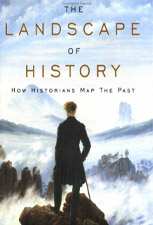Book Review
The Landscape of History: How Historians Map the Past
By John Lewis Gaddis. New York: Oxford University Press, 2002; 182 pp., illustrations, notes, index; cloth $23.00.
 |
In The Landscape of History, John Lewis Gaddis offers an insightful glimpse at what historians do. Based on a series of lectures given by the author at Oxford University, the book offers a welcome introduction to historical methodology and an overview of the state of the art. In this short and thought-provoking book, Gaddis tackles many critical issues about the precision of historical methodology and the objectivity of history in a very accessible and often witty manner.
Gaddis claims that historians are reluctant to make their methods explicit for fear that their writing might resemble the design of the Pompidou Center in Paris where all sorts of ducts, conduits, escalators, and other building systems run outside of the building. He remarks that this reluctance also causes confusion about what historians do and how they do it. Rather than describing in detail how historians ponder evidence and construct narratives, Gaddis attempts to show how historical methodology is as legitimate as scientific methodologies by illustrating many parallels between the methodology of history and those of astronomy, geology, and paleontology.
The idea that legitimacy in science can only be achieved by moving towards predictability is outdated as Gaddis points out. While many disciplines in the political and social sciences still hold to reductionist models established in the 19th century, the adoption of an evolutionary model by many disciplines in the natural sciences has brought about revolutionary change. Some of the catalysts for this change, as Gaddis observes, were the advent of chaos and complexity theories in the 1970s, which eroded many of the assumptions of older scientific models.
Gaddis also embarks on an eloquent exposition of the question of uncertainty in history and begins to counter the post-modernist critique of history. Historians, he writes, "can never actually rerun history any more than astronomers, geologists, and paleontologists, and evolutionary biologists can rerun time." Thus, history can only represent the past, and no matter how close the representation resembles the reality, the fit can only be provisional. Yet, even poor representations, as time goes by and as witnesses disappear, often become the reality. Historians may make the past legible but in doing so they also imprison it. While this is not done with malignant intent, the reader would be well served to know how a particular history was constructed.
The pursuit of history, as Gaddis sees it, is a work in progress. Richer, more complex, views can be constructed as new material surfaces. The task is not simply to give new answers to old questions, but also to ask new questions. Just as uncertainty cannot be taken out of history, neither can the particular perspective of the historian. Every work of history makes a moral judgment either explicitly or implicitly, consciously or unconsciously. The issue then is not how to avoid making judgments, but how to make them responsibly.
Gaddis's exhortation to historians to make their methods more explicit is particularly intriguing and leaves much room for expansion. A more elaborate treatment of the topic in a similar didactic style would be very useful, especially for the general reader. It would be interesting to know how, for example, when reading a piece on the Cold War, an uninitiated reader may evaluate the historian's methodology and what additional insight might be gained.
The broad scope of Gaddis's observations makes this book engaging for the cultural resources practitioner and for others interested in history. His observations invite us to question many commonly held assumptions about how we see and interpret the past. For this reason, the book can be particularly useful for those entrusted with preserving and interpreting important aspects of our national heritage. This book urges us to remember that making the past legible must be pursued without forgetting that no matter how perfectly the pieces may fit together, history is only an approximation. No matter how perfectly detailed our historical tableau it is only a representation. Finding the gaps in the stories and making them visible is also important so that new generations may continue to look for answers and pose new questions.
Antonio Aguilar
National Park Service
